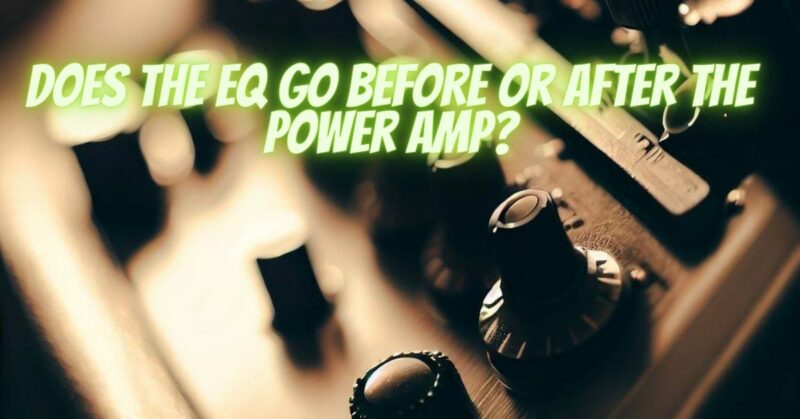Crafting the perfect guitar tone is a journey that involves various components and decisions, one of which is the placement of the EQ in your signal chain concerning the power amp. Whether you choose to position EQ before or after the power amp can significantly influence your overall sound, affecting factors such as tonal shaping, clarity, and character. In this article, we’ll delve into the considerations for each approach and help you make an informed decision based on your specific sound-shaping goals.
Understanding the Signal Chain
Before we explore the nuances of EQ placement, let’s familiarize ourselves with the typical components of a guitar signal chain:
- Guitar: The tone starts here, influenced by your choice of guitar, pickups, and playing technique.
- Effects Pedals: Various stompboxes, such as distortion, delay, and modulation effects, can shape your guitar signal.
- Preamp: The preamp stage in your amplifier adds gain and further tonal shaping. Many guitar amps also feature built-in EQ controls here.
- Power Amp: The power amp is responsible for amplifying the signal to a level that can drive your guitar speaker(s).
- Equalization (EQ): EQ controls the frequency balance of your signal, allowing you to boost or cut specific frequencies.
- Speaker(s): The final stage of your signal chain, where the amplified sound is projected.
Now, let’s explore the two options for EQ placement concerning the power amp.
EQ Before Power Amp
Advantages:
- Tonal Shaping: Placing the EQ before the power amp allows you to shape your core guitar tone before it undergoes amplification. You can tailor the frequencies to suit your musical style and objectives.
- Precise Control: EQ adjustments made before the power amp can be more precise, allowing you to fine-tune the frequencies with greater accuracy.
- Clean Signal Control: You have the ability to control the input signal going into the power amp, which can help maintain a cleaner and more controlled tone, especially when dealing with high-gain sounds.
Disadvantages:
- Less Traditional: Placing EQ before the power amp doesn’t replicate the traditional setup of using an amplifier’s EQ controls to shape your tone. Some guitarists prefer a more authentic feel.
- Limited Post-Processing: Any EQ changes made here are “baked” into the amplified signal, leaving less room for post-processing adjustments.
EQ After Power Amp
Advantages:
- Emulates Traditional Setup: Placing EQ after the power amp emulates the traditional approach where you adjust the amplifier’s EQ controls to shape your tone. This can provide a more authentic feel and behavior.
- Flexibility: You have more control over the tonal nuances and interactions of the post-amplified signal. This can be useful for fine-tuning your sound, especially in a live performance setting.
- Correction: If your power amp settings aren’t ideal, post-power amp EQ can help correct and enhance your tone.
Disadvantages:
- Less Direct Control: Adjusting EQ after the power amp can be less intuitive, as it’s akin to adjusting the tone controls on your amp after they’ve been set. It may require more experimentation to achieve the desired sound.
- Potential for Feedback: Applying EQ to an already amplified signal can increase the risk of feedback, particularly when boosting frequencies.
Choosing the Right Placement
The decision of whether to place EQ before or after the power amp should align with your tone-shaping goals and preferences. Here are some factors to consider:
- Tone Objectives: If you have specific tonal objectives and want to shape your core guitar sound before it undergoes amplification, placing EQ before the power amp is advantageous.
- Authenticity: If you value the authenticity of the guitar amplifier experience and prefer to emulate traditional amp control adjustments, consider placing EQ after the power amp.
- Control vs. Tradition: EQ before the power amp provides direct control over your initial tone, while EQ after the power amp offers greater flexibility but may require more effort to dial in the desired sound.
- Feedback Concerns: Be mindful of feedback risks when placing EQ after the power amp, especially when boosting frequencies.
- Live vs. Studio: Your choice may vary depending on whether you’re performing live or recording in a studio. Live situations often benefit from post-power amp EQ for real-time adjustments, while studio recording may allow for more pre-amplification shaping.
The placement of EQ in your guitar signal chain concerning the power amp is a decision influenced by your specific tone goals, creative vision, and workflow preferences. Both approaches have their advantages, and the right choice ultimately depends on your needs and how you want to shape your guitar sound. Experimentation and familiarity with your chosen placement are key to achieving your ideal guitar tone. Whether you’re fine-tuning your core tone or adding the finishing touches, the right EQ placement can elevate your guitar sound to new heights.

